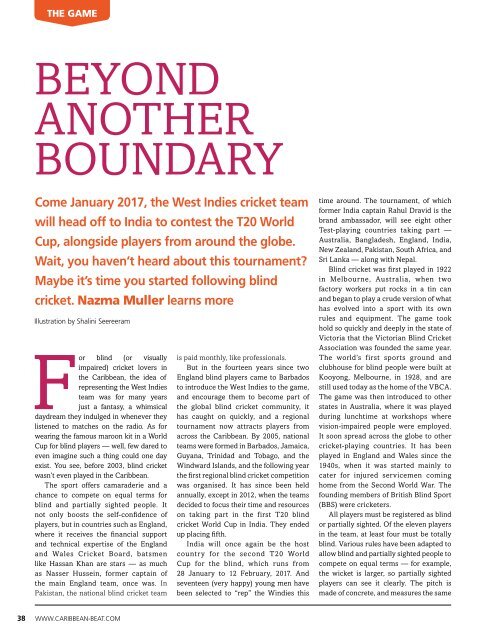Caribbean Beat — January/February 2017 (#143)
A calendar of events; music, film, and book reviews; travel features; people profiles, and much more.
A calendar of events; music, film, and book reviews; travel features; people profiles, and much more.
Create successful ePaper yourself
Turn your PDF publications into a flip-book with our unique Google optimized e-Paper software.
THE GAME<br />
Beyond<br />
another<br />
boundary<br />
Come <strong>January</strong> <strong>2017</strong>, the West Indies cricket team<br />
will head off to India to contest the T20 World<br />
Cup, alongside players from around the globe.<br />
Wait, you haven’t heard about this tournament?<br />
Maybe it’s time you started following blind<br />
cricket. Nazma Muller learns more<br />
Illustration by Shalini Seereeram<br />
For blind (or visually<br />
impaired) cricket lovers in<br />
the <strong>Caribbean</strong>, the idea of<br />
representing the West Indies<br />
team was for many years<br />
just a fantasy, a whimsical<br />
daydream they indulged in whenever they<br />
listened to matches on the radio. As for<br />
wearing the famous maroon kit in a World<br />
Cup for blind players <strong>—</strong> well, few dared to<br />
even imagine such a thing could one day<br />
exist. You see, before 2003, blind cricket<br />
wasn’t even played in the <strong>Caribbean</strong>.<br />
The sport offers camaraderie and a<br />
chance to compete on equal terms for<br />
blind and partially sighted people. It<br />
not only boosts the self-confidence of<br />
players, but in countries such as England,<br />
where it receives the financial support<br />
and technical expertise of the England<br />
and Wales Cricket Board, batsmen<br />
like Hassan Khan are stars <strong>—</strong> as much<br />
as Nasser Hussein, former captain of<br />
the main England team, once was. In<br />
Pakistan, the national blind cricket team<br />
is paid monthly, like professionals.<br />
But in the fourteen years since two<br />
England blind players came to Barbados<br />
to introduce the West Indies to the game,<br />
and encourage them to become part of<br />
the global blind cricket community, it<br />
has caught on quickly, and a regional<br />
tournament now attracts players from<br />
across the <strong>Caribbean</strong>. By 2005, national<br />
teams were formed in Barbados, Jamaica,<br />
Guyana, Trinidad and Tobago, and the<br />
Windward Islands, and the following year<br />
the first regional blind cricket competition<br />
was organised. It has since been held<br />
annually, except in 2012, when the teams<br />
decided to focus their time and resources<br />
on taking part in the first T20 blind<br />
cricket World Cup in India. They ended<br />
up placing fifth.<br />
India will once again be the host<br />
country for the second T20 World<br />
Cup for the blind, which runs from<br />
28 <strong>January</strong> to 12 <strong>February</strong>, <strong>2017</strong>. And<br />
seventeen (very happy) young men have<br />
been selected to “rep” the Windies this<br />
time around. The tournament, of which<br />
former India captain Rahul Dravid is the<br />
brand ambassador, will see eight other<br />
Test-playing countries taking part <strong>—</strong><br />
Australia, Bangladesh, England, India,<br />
New Zealand, Pakistan, South Africa, and<br />
Sri Lanka <strong>—</strong> along with Nepal.<br />
Blind cricket was first played in 1922<br />
in Melbourne, Australia, when two<br />
factory workers put rocks in a tin can<br />
and began to play a crude version of what<br />
has evolved into a sport with its own<br />
rules and equipment. The game took<br />
hold so quickly and deeply in the state of<br />
Victoria that the Victorian Blind Cricket<br />
Association was founded the same year.<br />
The world’s first sports ground and<br />
clubhouse for blind people were built at<br />
Kooyong, Melbourne, in 1928, and are<br />
still used today as the home of the VBCA.<br />
The game was then introduced to other<br />
states in Australia, where it was played<br />
during lunchtime at workshops where<br />
vision-impaired people were employed.<br />
It soon spread across the globe to other<br />
cricket-playing countries. It has been<br />
played in England and Wales since the<br />
1940s, when it was started mainly to<br />
cater for injured servicemen coming<br />
home from the Second World War. The<br />
founding members of British Blind Sport<br />
(BBS) were cricketers.<br />
All players must be registered as blind<br />
or partially sighted. Of the eleven players<br />
in the team, at least four must be totally<br />
blind. Various rules have been adapted to<br />
allow blind and partially sighted people to<br />
compete on equal terms <strong>—</strong> for example,<br />
the wicket is larger, so partially sighted<br />
players can see it clearly. The pitch is<br />
made of concrete, and measures the same<br />
38 WWW.CARIBBEAN-BEAT.COM


















